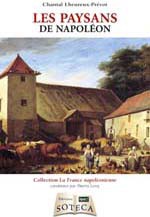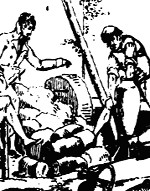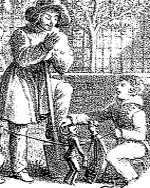Irène Delage: Chantal Lheureux-Prévot, your first book offers a panorama of rural life during the Empire: what "inspired" you to begin this work?
Chantal Prévot: My initial research into daily life in the countryside – and in towns, I should add – was driven by queries from visitors to the library and to the website. This research went on to form the basis for a number of papers that I wrote at the Fondation Napoléon. Being a librarian, I have access to a tremendous amount of information! New and old books, current and historical reviews, pamphlets: they all come by my desk before being catalogued, indexed and made available to the public. The arrival of online digital libraries has further enriched the ever-increasing resources available to us. I also oversee the Fondation's online library of Napoleonic texts, so you could say that I'm on the front line when it comes to gathering information.
I.D.: In your introduction, you remind us that rural culture was essentially an oral culture: what approach did you take and what sources did you use to overcome this particular obstacle?
 C.P.: The research – you could even call it a 'quest' – was fascinating: the realities of daily life are there to be gleaned from biographical narratives, travel accounts, private correspondence, administrative reports and 'popular' literature, itself often of a practical nature. I'm talking about cookery books, farming manuals, even books teaching children their ABC. The majority of these had a particular purpose in mind and thus offer precious insight into daily life. Images, such as engravings and prints, were also useful in providing additional information.
C.P.: The research – you could even call it a 'quest' – was fascinating: the realities of daily life are there to be gleaned from biographical narratives, travel accounts, private correspondence, administrative reports and 'popular' literature, itself often of a practical nature. I'm talking about cookery books, farming manuals, even books teaching children their ABC. The majority of these had a particular purpose in mind and thus offer precious insight into daily life. Images, such as engravings and prints, were also useful in providing additional information.
I.D.: Having come to the end of your research, how would you define the "rural world"? You talk about a number of regions, all differing greatly the one from the other, and very diverse social situations, but are there any similarities that can be seen across the board?
C.P.: The “rural world” lived with a sort of fatalism that helped them accept certain physical hardships and moral difficulties in their lives, but that should not be taken to mean that they were lacking in common sense; they got by, and often displayed a canniness that belies this general acceptance of their lot. The search for happiness did indeed exist, which went far beyond what the local elites perceived to be resignation to their fate; however, this happiness was often found in little things and was rarely talked about.
I.D.: Could it be said that the "rural world" existed on two different time scales: a long-term that shows that the peasantry changed little between the 17th and 19th centuries (lifestyle, mentalities), and a shorter-term which takes in its adjustment to the upheavals of the 18th century and the French Revolution?
 C.P.: Absolutely. On first impression, the rhythm of daily life and general attitudes seem unchanging, subject simply to the seasons and the whims of authority, be it royal, imperial, religious or superstitious in nature. But a closer look at the lives led by these peasants, craftsmen, workmen and local village leaders reveals some profound changes hidden behind the facade. These, for the most part, took place unnoticed; even those involved were more often than not unaware of it. It was first of all the countryside opening up to the wider world, due to a number of factors: improvements in the state's road network made commercial and intellectual exchanges easier – posted to different countries and regions all over Europe, the young army conscripts returned home with their daily habits profoundly altered. The intensification in industry production, on a local and national scale, made goods once considered 'luxury items' more common in the countryside.
C.P.: Absolutely. On first impression, the rhythm of daily life and general attitudes seem unchanging, subject simply to the seasons and the whims of authority, be it royal, imperial, religious or superstitious in nature. But a closer look at the lives led by these peasants, craftsmen, workmen and local village leaders reveals some profound changes hidden behind the facade. These, for the most part, took place unnoticed; even those involved were more often than not unaware of it. It was first of all the countryside opening up to the wider world, due to a number of factors: improvements in the state's road network made commercial and intellectual exchanges easier – posted to different countries and regions all over Europe, the young army conscripts returned home with their daily habits profoundly altered. The intensification in industry production, on a local and national scale, made goods once considered 'luxury items' more common in the countryside.
 Young women could finally get hold of softer fabrics, younger members of society became accustomed to going to the tavern on a Sunday to drink beer, and the family room even got a clock. An increase in salaries (especially for those employed in agriculture and farm owners) allowed families to quench their thirst for comfort and luxury. Unsurprisingly, the religious, administrative and governing elites were highly critical of such changes. As far as they were concerned, a good peasant was a hard-working peasant, satisfied with his lot, regardless of how hard it was, and resigned to his fate. These same elites sought to minimise the effects of the Revolution in the countryside and suppress its libertarian ideals. The social and economic model initially appeared to survive the “great upheaval”, as some liked to call the turbulent ten years following the Revolution. And yet the seeds had been sown. The gestation period may have been long, but these ideas radically altered the foundations of society in the countryside. One final example: familial, and more precisely patriarchical, piety became to crumble. Absolute respect for the Pater familias and his decisions (such as choosing his sons' profession, and the principle of the eldest following in the footsteps of the father) no longer went without saying. The idea of deciding one's own fate, and looking beyond the family unit and one's own social heritage, began to take hold.
Young women could finally get hold of softer fabrics, younger members of society became accustomed to going to the tavern on a Sunday to drink beer, and the family room even got a clock. An increase in salaries (especially for those employed in agriculture and farm owners) allowed families to quench their thirst for comfort and luxury. Unsurprisingly, the religious, administrative and governing elites were highly critical of such changes. As far as they were concerned, a good peasant was a hard-working peasant, satisfied with his lot, regardless of how hard it was, and resigned to his fate. These same elites sought to minimise the effects of the Revolution in the countryside and suppress its libertarian ideals. The social and economic model initially appeared to survive the “great upheaval”, as some liked to call the turbulent ten years following the Revolution. And yet the seeds had been sown. The gestation period may have been long, but these ideas radically altered the foundations of society in the countryside. One final example: familial, and more precisely patriarchical, piety became to crumble. Absolute respect for the Pater familias and his decisions (such as choosing his sons' profession, and the principle of the eldest following in the footsteps of the father) no longer went without saying. The idea of deciding one's own fate, and looking beyond the family unit and one's own social heritage, began to take hold.
I.D.: What would you like the reader to take away with them having read this account of rural society at the start of the 19th century?
C.P.: A sense of respect for these “little” people who left barely a trace on the historical landscape and who laboured hard for what they had; surprise and perhaps even amusement at the idea that these men and women lived and thought in a way not a million miles away from how we do today. After all, we're talking about little more than two hundred years: that's five or six generations at most, almost our grandparents!


